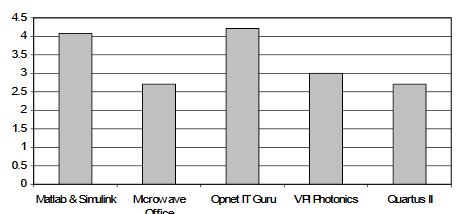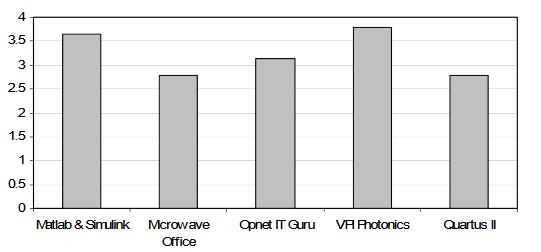ABSTRACT
The use of software tools and simulators in the education field has a growing interest in most of universities and educational procedures. Nowadays, in university education new technologies are used to improve and complement the theoretical concepts explained in class. In this paper we are going to present the simulation tools most used in Telecommunication Engineering at the Polytechnic University of Valencia.
These programmes are also used in other fields such as in the industry and researching. After presenting the main characteristics of each software tool, a questionary study is included to analyze the benefits and drawbacks of each tool from the point of view of the student, its complexity and advantages for educational purposes.
RELATED WORKS
In this section, we present several works where we can see the use of software tools and simulators in education. we can see a study of two networks simulators used to teach in Computer Networks subjects. This study examines the main features of these simulators and then discusses the advantages and disadvantages of each simulator from the point of view of the student and teacher.
SOFTWARE TOOLS IN TELECOMMUNICATIONS ENGINEERING
In this section we present the main software tools that are used in the Technical school of Telecommunications of the Polytechnic University of Valencia. The subjects of the degree are divided into several areas. For this reason, we wanted to present the most important tool of each area. The relationship between the areas and the software applications that will be explained in the following subsections are the next ones:
1. Signal processing → Matlab & Simulink.
2. Signal transmission → Microwave Office.
3. Telematic → Opnet IT Guru.
4. Optical communications → VPI Photonics.
5. Electronics → Quartus II.
QUESTIONARY
In this section, the method used to evaluate the previous software tools is presented. This analysis will point out the benefits and drawbacks of each software tool from the educational point of view. We have made a study with 50 students. Some of them are at final courses of the degree and others are already graduated in the Telecommunication Engineering degree of the Polytechnic University of Valencia.
RESULTS

Fig. 2. Results for the second question
Fig. 2. is focused on the compatibility of each tool with different operating systems. All of them have results above to 2.5 points. Matlab & Simulink and Opnet IT Guru have greater facilities. Moreover, these software tools have not problem with the exchange of files with different operating systems.

Fig. 4. Results for the fourth question
In the Fig. 4 we see which tools provide greater number of examples or documentation. In this aspect Matlab & Simulink and VPI Photonics are the software tools that have more tutorials and examples, according to the students. Microwave Office and Quartus II are the worst.
CONCLUSIONS
In this paper we have studied and compared several software tools and simulators that are used in several subjects inside Telecommunication engineering career. This study and comparative has a global and not technical character. In this study, we have presented the benefits and drawbacks of each software tool from the point of view of the student.
Once these characteristics are shown, lecturers have to choose the most adequate simulation tool for our purposes. The election should involve the most interesting points of this paper. Finally, the resources offered by new technologies such as simulating tools, involve very positive experiences for students and teachers and contribute to improving the teaching-learning process.
Source: Polytechnic University
Authors: Miguel Garcia | Hugo Coll | Diana Bri | Jaime Lloret
>> More Matlab Projects for Telecommunication for Final Year Students